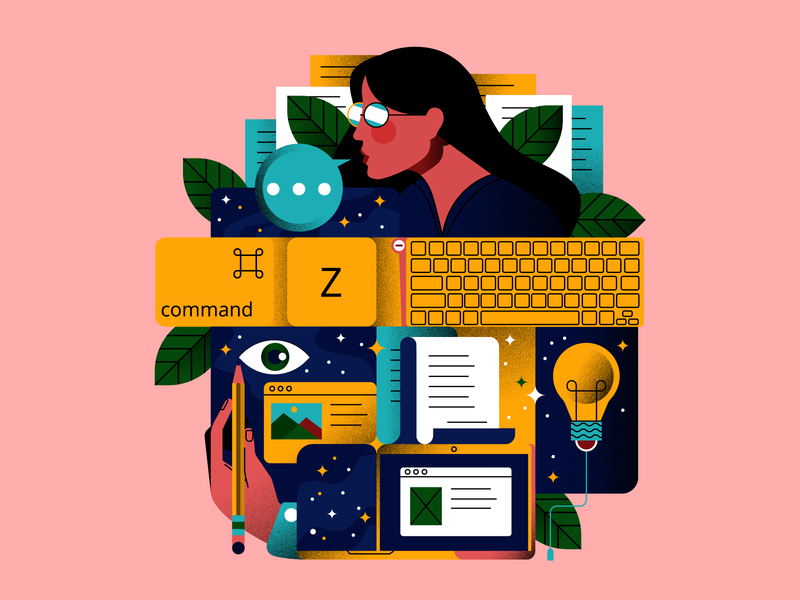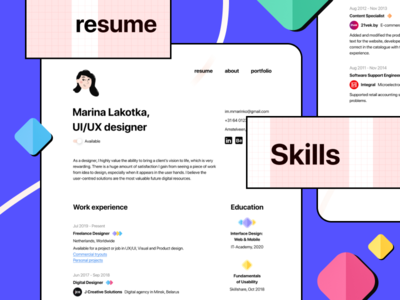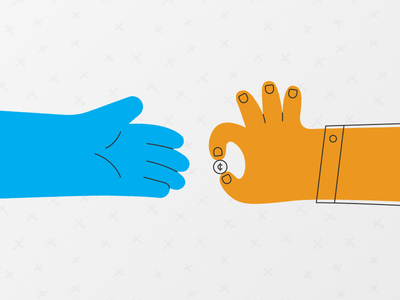If you want to get hired in UX design, you need to know what design managers are specifically looking for in their candidates. We’ve talked to design recruiters, hiring managers, and UX coaches to bring you an ultimate guide to getting hired in UX design.
With their help, we broke down the most important factors for UX designers to consider throughout the job search process—your portfolio, your UX resume, the interview itself, and everything in between. So let’s get started:
1. Your Portfolio
Crafting a UX portfolio is no small feat, but if you do it right, you’ll reap major dividends in the job search process. Design Recruiter at Figma Korin Harris has a few portfolio-building tips to share:
“I see a lot of portfolios as a design recruiter. Applicants often make the same mistakes again and again—from including far too much text in project highlights, to overcomplicating animations on their landing page. I recommend you build your product design portfolio the same way you would tackle any design challenge: Start by putting yourself in the shoes of your target audience.
Leaders like this are very busy. They’re always running to their next meeting, phone call, or candidate interview, so they have limited time to review a portfolio (we’re talking minutes or even seconds). They’re trying to quickly parse a lot of information in that short period of time:
- What type of design you do
- Where your talents and passions lie
- Whether you have the right experience for this particular role
- How you tackle design challenges
- Your overall design abilities
You can’t expect them to dig through pages of content to figure this stuff out. Instead, you need to spoon-feed the most pertinent information for the particular role you’re applying for.”
Landing Page Tips:
How many clicks does it take to get to your work? Does your landing page only consist of “about you” content? Click. Is your “work” icon in the upper right-hand corner? Click. Are your projects laid out so you have to pick one? Click.
Your target audience can’t go hunting for information. Your homepage should give them an overview of your design projects, so they’re only one click away from your work.
Projects to display:
Tailor your project choices based on your career goals. Are you interested in mobile, web, or virtual reality design jobs? Make that clear by highlighting your experience in that area. Are you dying to quit the e-commerce industry and want to move into fintech, healthcare, or something else? Choose previous work accordingly.
“Tailor your projects” may seem like obvious advice, but applicants often struggle with this. They try to capture the entire breadth of their design career in one portfolio. They assume people will take the time to go through everything—but hiring managers often can’t.
For more UX portfolio tips see How to create a UX portfolio to land your first job
2. Your Resume
To create a stand-out user experience resume, UX designer and coach Sarah Doody recommends doing the following:
- Tailor your resume to each role you apply to: Before you apply to a role, you should devour the job description because that’s where you can find out exactly what recruiters and hiring managers are looking for. Based on what you find in the job description, use this to tailor your resume for each role. By tailoring you could:
- Think of yourself as a product: The company is hiring you to do a job for them. What do great products do? They don’t just talk about their features. Instead, they highlight their benefits. By benefits, focus on the outcomes you’ve achieved. For past projects you worked on, what happened? What was the benefit to the team, business, or product?
- Include a title and a personal elevator pitch: Often times, especially in UX, job titles mean different things to different people. Ask 10 people what a “UX Designer” specifically does, and you’ll get 10 different answers. I recommend that you not only give yourself some type of title, but also have an elevator pitch. Your title quickly lets people know what you do at a high level. The elevator pitch helps clarify exactly what you do, and what you don’t do.
Check out the rest of Sarah’s resume building tips in her ultimate guide to designing a stand-out UX resume.
3. The Interview Process
Now that you’ve got your portfolio and resume ready, it’s time to prepare for the actual interview! Design Recruiter at Facebook, Carl Wheatley explains why proactive storytelling in a UX design interview is one of the most powerful techniques for demonstrating your expertise and communication skills:
“I’ve understood something from my many years of experience with UX interview sessions, which is the difference between telling your interviewers about you and showing them something about you. Which do you think is more powerful? I choose the latter because it’s been my greatest weapon in winning interview sessions and landing the job.
There’s no better way to shine during an interview than sharing a few compelling stories about your best design work. Your interviewers are always interested in learning about your past experiences, especially when you share them through captivating stories that help them make informed decisions faster. Anyone can tell an interviewer “I know how to run a usability test.” Instead, share the story about how you once ran a usability test and what the outcome was.
Hiring managers, like most people, are more captivated by stories than facts or data alone. Just remember not to go off tangent by sharing stories that aren’t related to the position you’re applying for. You don’t need to share stories about your degrees, family, or whatever. Focus on your working experiences, awards if any, your ultimate roles, the changes you’ve enacted, and the teams you’ve worked with.”
Here’s a list of 21 questions to expect in a UX interview and how to approach answering each one.
4. Negotiating Your Salary
Remember, the sharpest candidates also spend time researching and preparing for one of the most important yet often anxiety-inducing questions: “What salary are you looking to make?”
Based on her experience facilitating interviews between designers and hiring managers, Alayna Burton shares a few tips for approaching the salary conversation:
- Do your research. What is the average salary for your design discipline? How many years of experience do you have? Know your numbers.
- It’s always acceptable to bring up your salary expectations in an interview. You’ll end up saving both you and the employer’s time if it’s not the right fit.
- The initial offer is typically not the final offer. Don’t be afraid to counter the first offer if it’s not too far off from what you asked for. There’s likely a little wiggle room.
- Don’t forget to discuss your compensation package (health insurance, perks, etc.)—negotiations can also be made in this area.
- Know your worth. It’s ok to walk away from a job offer if it isn’t right.
For more salary negotiation tips from Alayna, check out How to negotiate your design salary like a pro
5. The Follow-Up
Never underestimate the power of a follow-up message! Design Recruiter at Facebook Carl Wheatley explains why this is important and suggests some helpful language to use:
After applying to a company, send a nice message to their recruiter or hiring manager letting them know you applied and are very interested in the role. This goes a long way. I recommend following up twice within the first month you applied. After that, I’d wait a month before you message them again. It always helps to follow up! Not everyone will reply, but it’s certainly worth doing. Here’s an example of the type of messaging you can use:
“Dear Carl, I’m a huge fan of Dribbble and how you connect all of us designers around the world. I applied to your UX Designer position and believe I could add a lot of value to your team. Please review my portfolio and feel free to reach out with any questions regarding my experience.”
Takeaways
We hope you found all of these tips helpful! At the end of the day, remember that hiring managers especially want to see that you are a stellar communicator and have confidence in your expertise. Put yourself in their shoes when crafting your portfolio and resume, and remember that the interview process is where you should let your communication skills shine. With the help of these tips, you’ll be well on your way to landing your next best UX design job.
More UX Hiring Resources:
- 3 design storytelling tips to nail your UX interview
- 9 tips for landing a design job after design school or bootcamp
- How to build a product design portfolio to get you hired
Find more Process stories on our blog Courtside. Have a suggestion? Contact stories@dribbble.com.
















